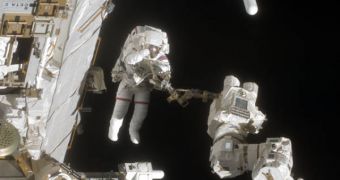Yesterday, Endeavor Astronauts Dave Wolf and Chris Cassidy performed an extra-vehicular activity (EVA) on the International Space Station (ISS), aimed at replacing a few of the laboratory's oldest batteries. NASA planned that four of six packages be removed during the six-hour spacewalk, but that objective was not accomplished. A small error in Cassidy's spacesuit forced mission controllers to scrub the mission, and directed the astronauts back inside. NASA explains that the glitch was a small fluctuation in the air-scrubbing gear, which resulted in slightly elevated carbon dioxide levels.
However, the American space agency also says that it never takes any chances with spacesuit errors during EVAs, and that any glitch will be dealt with as safely as possible. “I guess we're getting off early today,” Wolf said as the two were heading towards a station airlock. According to experts, it was not overexertion on the part of Cassidy that led to the elevated CO2 readings, but a malfunction of the systems. The astronaut experienced no effects from exposure to higher carbon dioxide concentrations.
“Certainly, folks are very interested in understanding the root cause of the signature that we saw today,” Holly Ridings, the lead space station flight director, added after the incident, while speaking to reporters on Wednesday. During the spacewalk, the team only managed to replace two out of the scheduled four batteries. The ISS has a total of six such packages, which were supposed to be replaced on Wednesday and Thursday, in two EVAs. Yesterday's mission was cut short by about half an hour. The batteries the astronauts had to work with bear no resemblance to commercial ones.
They weigh some 170 kilograms and are about the size of a refrigerator. Originally designed to last six and a half years, the ones currently aboard the space station have been in use for about nine years, and mission experts hope to get a much-needed power boost once all the new ones are in place. The astronauts also added layers of insulation to power lines that allow incoming space shuttles to connect to the power grid on the station, making them easier and safer to operate, Space informs.

 14 DAY TRIAL //
14 DAY TRIAL //